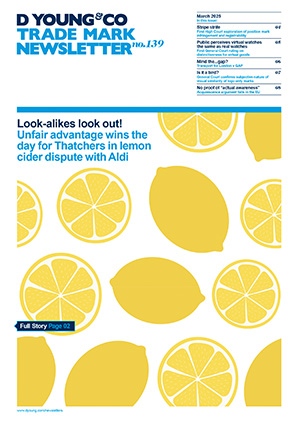Monster Dawg crushed by Red Bull: High Court appeal for RED DAWG fails
Monster Energy Company (Monster), listed as the number 1 “All Time Biggest Bully” on the trademarkia.com website, is a manufacturer of energy drinks. It applied to register RED DAWG as a trade mark in the UK. Red Bull, another energy drinks manufacturer, successfully opposed the registration of Monster’s proposed mark, relying on its earlier rights in RED BULL.
Before the UKIPO
The UK hearing officer rejected Red Bull’s objection based on a likelihood of confusion under s.5(2)(b) of the UK Act. He concluded that there was no likelihood of direct or indirect confusion between the marks, even in relation to goods that are identical. However, he upheld Red Bull’s objection based on a claim of unfair advantage under s.5(3).
Monster appealed to the High Court.
Basis for a dilution/detriment/unfair advantage claim
As a brief recap, there are three strands to a successful 5(3) objection:
- that the earlier mark has a reputation in the UK (it was not contested that the mark RED BULL satisfied this);
- that use of the contested mark would “call to mind” the earlier mark, such that the consumer of the goods would make a “link” with the earlier mark; and
- as a result one of three forms of injury would arise:
- detriment to the distinctive character of the earlier mark;
- detriment to the reputation of the earlier mark; or
- taking unfair advantage of the earlier mark, the last of these being the one found by the hearing officer.
The appeal to the High Court
Monster contended that the hearing officer conflated the question of there being a link and the taking of an unfair advantage leading to the error in the decision they sought to overturn. Monster submitted there was no evidence of a link and, further, merely having an advantage as the later mark is permissible. The opponent needs to show that the advantage is unfair to succeed.
The High Court judge, Mr Justice Adam Johnson, whilst noting that the single concluding paragraph in the hearing officer’s decision was rather “compressed” nevertheless held that the hearing officer’s analysis was logical and not open to appeal.
The hearing officer had clearly found that:
- the RED DAWG mark was intended to influence the economic behaviour of consumers of Monster energy drink products.
- consumers encountering the later RED DAWG mark would “certainly be reminded” of the earlier RED BULL mark, even if they were not confused between them.
- it would be easier for Monster to establish and sell its RED DAWG energy drinks without incurring the marketing costs that would otherwise have been required.
- there was no “due cause”, and so s.5(3) was engaged.
The judge also considered the earlier case law Jack Wills Limited v House of Fraser (Stores) Limited [2014] EWHC 110 (Ch) and concluded: “…[an] unfair advantage [can be found] even if it is not proved that the defendant subjectively intended to exploit that reputation and goodwill”.
The judge added “that the court or tribunal can permissibly draw inferences based on the inherent probabilities and by taking account of normal practice in the relevant sector and the circumstances of the case. The court or tribunal cannot proceed on the basis of “mere suppositions”, but an inference based on the inherent probabilities and the normal practice in the relevant sector will not be a mere supposition. It will be a rational and properly motivated conclusion.’
And thus, the judge concluded, it was entirely legitimate for the hearing officer:
- to proceed on the basis that in adopting the RED DAWG mark Monster was intending to seek to influence the economic behaviour of consumers of their products – indeed, that would seem the most obvious reason for doing so; and
- to infer that the similarity between RED BULL and RED DAWG, although not apt to cause confusion, would nonetheless make it easier for Monster to sell its products without incurring the marketing costs that would otherwise have been required.
He added: “Both appear to me to be entirely legitimate and common-sense propositions.”
Monster’s appeal failed and was dismissed.
So what are the three take away points?
First, a reminder, that merely because under 5(2)(b) there was no likelihood of confusion between the marks did not adversely prejudice Red Bull’s case. The question under s.5(3) was a different one, namely whether consumer behaviour was likely to be influenced in a way which produced an objectively unfair result.
Second, the assessment of unfair advantage is an objective one and thus, for brand owners, it isn’t necessary to evidence an advantage as being unfair. Whilst a tribunal cannot proceed on the basis of “mere suppositions”, it is acceptable for the tribunal draw inferences in reaching a decision. A question: to what extent is there a clear difference between a supposition and an inference?
Finally, the bar to overturn a first instance decision from the UKIPO on appeal is set high. The court should not interfere unless it is satisfied that the decision is one which clearly should not have been made.
Monster’s website for its RED DAWG page currently says “Be right back”. Let’s see…
